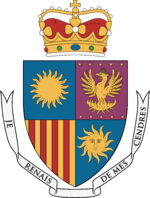Government and politics of Nouvelle Alexandrie

|
This article or section is a work in progress. The information below may be incomplete, outdated, or subject to change. |
The Federation of Nouvelle Alexandrie is a federal state governed within the framework of a parliamentary democracy under a constitutional monarchy in which the monarch, currently King Manco Capac I, is the head of state while the President of the Government (also known as the “Premier”), currently Paolo Antonio Aguilar (since 1718 AN of the Federal Humanist Party, is the head of government.
Executive power is exercised by the New Alexandrian government, on behalf of and by the consent of the King, and the governments of the 11 Regions. After the King and the President of the Government, the Council of State of Nouvelle Alexandrie is the most important executive government body, composed of the President and Vice-President of the Government, Cabinet Secretaries, and other government officials.
Legislative power is vested in the two chambers of the Cortes Federales of Nouvelle Alexandrie, the Federal Assembly and the Chamber of Peers, as well as in the regional legislatures.
The judiciary is independent of the executive and the legislature. The highest court is the High Court of Justice. The independent judiciary is based upon the civil law system which evolved from the codes of law of Alexandria, Caputia, and Natopia. The New Alexandrian judiciary also includes various bodies that check abuses of government power and other independent agencies.
Nouvelle Alexandrie’s political system is a multi-party system. During the early years of the Federation, regional and national parties often united into grand coalitions or political unions, often of a temporary nature, to achieve power and have a majority in the Federal Assembly. The first elected Government of the Federation was a Government of National Unity, composed of the Federal Humanist Party, Cambio Democratico, and the Digger’s Society. However, over the years, there has been much political consolidation in New Alexandrian politics. Many of the smaller parties have merged with larger ones and others have dissolved as political energy shifted to other parties and movements. Currently, the system is dominated by two large parties: the Federal Humanist Party, a center-right party, and the Federal Consensus Party, a centrist-liberal party. The Social Democratic & Liberal Alliance, a center-left party, was once the second largest party until the election of 1718. There is a strong tradition in New Alexandrian politics of maintaining independent candidacies and members of the legislature, making these types of candidacies common, especially for views or causes that do not find an immediate home in any of the current political parties.
The constitution of the Federation of Nouvelle Alexandrie is the Proclamation of Punta Santiago. The Proclamation serves as both the founding document of the Federation and its central constitutional charter. The Proclamation has been revised and amended several times to fit the needs and make changes to the terms of governance of the Federation by the Federal Constituent Assembly in the years leading up to the 1693 general elections to elect the first Cortes Federales.
The Federation is also responsible for one territory, called Jaris. Formerly known as Ijubicastagrad, Jaris is considered an “outremer territory”, meaning an area directly controlled by the national government that is not considered "incorporated" for the purposes of federal law. This territory is established as "unincorporated territory" under the direct rule of the King or to another legally incorporated body "on behalf of the King". In the absence of an organic law (a lawful regional, or local constitution or charter) approved by the federal legislature, a territory is classified as unorganized. Selected constitutional provisions apply, depending on legislative acts and judicial rulings according to the constitutional practice, local tradition, and law of Nouvelle Alexandrie.
